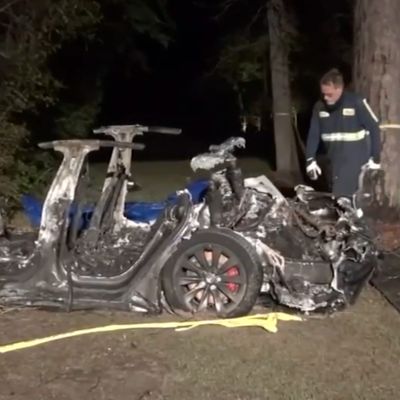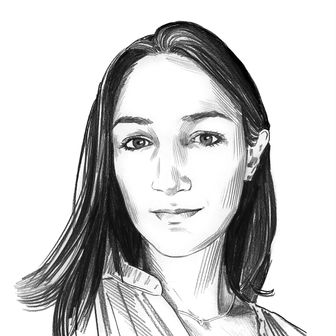
A Tesla crashed into a tree in a Houston suburb Saturday night, leaving its two male passengers dead. When the flames of the burning car were finally extinguished after four hours, the wreckage also left behind a mystery that has so far puzzled Tesla drivers, investors, and the company itself: Neither one of the men in the car had been sitting behind the wheel.
That was the conclusion reached by police on the scene, who found one body in the backseat and another in the passenger seat, and were “100 percent certain that no one was in the driver seat driving that vehicle at the time of impact,” an official told local news station KHOU. Authorities say the Model S sedan was traveling at high speed when it failed to negotiate a turn and hit the tree head-on.
While Tesla has not released a statement about the crash (nor responded to requests for comment from this or any other media outlet), its CEO Elon Musk offered some clues — and raised even more questions — in responding to a tweet earlier this week. The car’s owner had not purchased Tesla’s “Full Self-Driving” capability, Musk wrote, a $10,000 add-on that the company says can steer the car through lane changes, slow down at red lights and park automatically. And the “data logs” that Tesla had recovered from the car “so far show Autopilot was not enabled,” Musk wrote, referring to a more basic feature that can put the car into cruise control and help take over the steering. Tesla’s instructions explain that the features still require “active” supervision — a driver must agree to keep their hands on the wheel to turn on Autopilot — and “do not make the vehicle autonomous.”
If Musk is right, and Autopilot was never turned on, it makes even less sense why the owner got into the backseat just as it left the driveway, as a brother-in-law of one of the victims told another local news channel, KPRC 2. Did he think he’d turned on Autopilot but actually, tragically failed to do so? Perhaps Autopilot was initially enabled, but had disengaged by the time of the crash? We don’t know, and likely won’t have definitive answers until the National Highway Traffic Safety Administration (NHTSA), which has launched a special team to investigate the crash, publishes its report, which could take years. Its sister agency, the National Transportation Safety Board, is also investigating with a focus on the vehicle’s operation.
A possible explanation may come from Consumer Reports, which itself undertook an “experiment” following the accident to see if it could fool a Tesla into driving on Autopilot without anyone behind the wheel; in the results it published along with a video Thursday, it demonstrated “how easy it was” to put the Tesla on Autopilot and hop to the passenger side, without the car realizing anything was amiss. It’s plausible that the owner turned on Autopilot while still in the driver’s seat, then jumped in the back, maybe in an attempt at a sort of “Look ma, no hands” party trick.
Musk had claimed in his tweet that Autopilot could not have been activated in this case because the street did not have lane lines, which the feature requires. But a Tesla owner posted a video that appears to prove the opposite.
In the end, it may have been hubris, or overconfidence in Tesla’s technology, that led the joyride to end in catastrophe. While any number of Tesla owners could have attempted to drive with Autopilot without sitting in the driver’s seat, this may be the first known instance where they’ve died doing so. The NHTSA has opened 28 investigations into Tesla crashes, according to a spokesperson, but only four of those have been completed. Of the four, only one of which was fatal, the operator was in the driver’s proper seat behind the wheel in each case, the reports concluded.
As is usual whenever a Tesla crash makes headlines, the company’s stock fell precipitously. Adam Jonas, a Morgan Stanley analyst and a notable Tesla bull, published a note Wednesday evening after investors had peppered him with questions relating to the Tesla accident. In short, he isn’t concerned; he’s still forecasting a big jump in Tesla stock. After all, in a not-too-distant future, he believes, Teslas won’t even have steering wheels, because they’ll be autonomous and driverless; a decision made in the name of safety. Of course, nor will mere mortals be able to own such cars. In other words, the key to safety is removing humans from the equation entirely: the robots must become better drivers than us — much better. “‘Safer than human’ driving is nowhere near good enough,” he wrote. “Try 1,000 times or even 10,000 times safer.”
Until then, the best bet is to just keep your hands on the damn wheel.






























